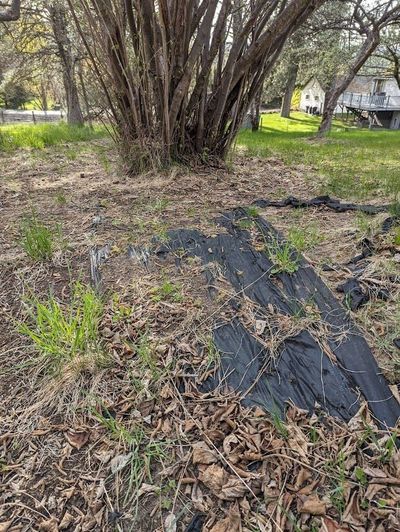Gardening: Landscape fabric is a temporary solution that becomes a problem

Landscape fabric, once considered the magic bullet for keeping weeds out of garden beds, is proving to be as much of a problem as the weeds it supposedly was to stop.
On the surface, the theory behind its use made perfect sense. Block the light and weeds won’t grow. In reality, the fabric has proved to be more work than it’s worth and an environmental problem.
Landscape fabric is a dark colored, woven or spun fabric that allows water and air into the soil while blocking the light that weeds need to sprout. In the home landscape, it is often laid down in shrub and perennial beds and then covered with bark, wood chip, top soil, gravel or compost mulch. Plants are planted through holes cut in the fabric. This seems to work well for a year or so before problems begin to set in.
First, organic mulches like bark, wood chips and compost break down quickly making them hospitable to any weed seed that blows in or is carried in by a bird. That seed quickly sprouts and you are back to weeding. In gravel and rock mulches, dust, dirt and garden debris are easily blown into the mulch, providing pockets of soil for weeds to get a foothold.
Second, landscape fabric is usually laid down and then holes are cut to plant the plants. Each time a hole is dug, weed seed is brought to the surface in the soil and scattered on top of the fabric. The more holes you dig through the fabric, the more potential there is for weed seed to find its way to the surface on top of the fabric.
Third, while the fabric allows water and air into the soil, it limits the natural movement of these elements into the soil, reducing soil health over time. Without a good exchange of air, water and nutrients, plants don’t develop strong, resilient root systems and can decline or even die.
Vigorous roots can break through the fabric in both directions. Once tied up in the fabric, they are almost impossible to remove without tearing up the fabric in the process.
Last, landscape fabric is tough to remove. Pulling it up from an established bed means removing the mulch on top of it before the fabric can be removed. This is a hard job, especially if roots are tangled in the fabric. Then there is the problem of disposing of the fabric in the trash.
A better option than landscape fabric is to use a thicker layer of quality bark, pine needle or wood chip mulch on the beds. A 3- to 4-inch layer of mulch is deep enough to discourage most weeds, and the ones that do pop up are often much easier to pull.
The mulch can be renewed every three or four years to replace what’s rotted down. Shredded pine needles make an excellent mulch and are free if you have trees in your yard. They don’t acidify the soil.